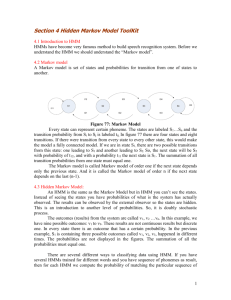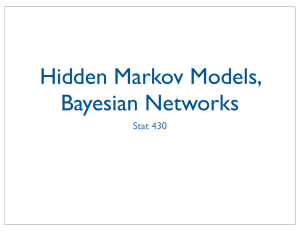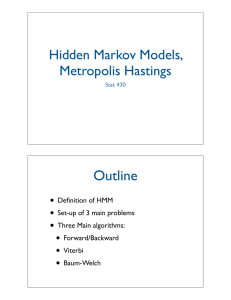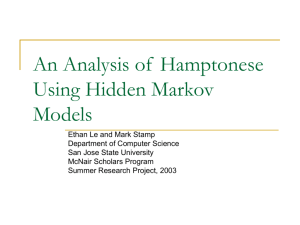Markov Models SCIA 2003 Tutorial: = f [y
advertisement
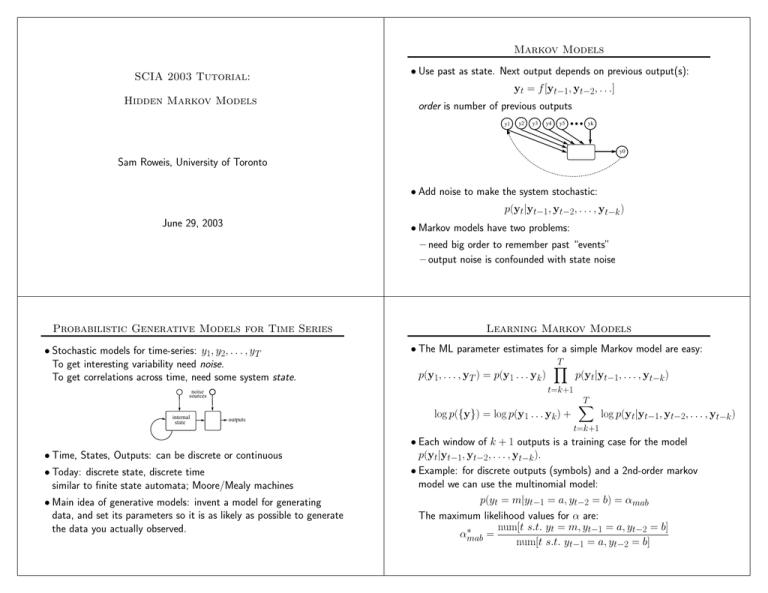
Markov Models
SCIA 2003 Tutorial:
Hidden Markov Models
• Use past as state. Next output depends on previous output(s):
yt = f [yt−1, yt−2, . . .]
order is number of previous outputs
y1
y2
y3
y4
y5
yk
y0
Sam Roweis, University of Toronto
• Add noise to make the system stochastic:
p(yt|yt−1, yt−2, . . . , yt−k )
June 29, 2003
• Markov models have two problems:
– need big order to remember past “events”
– output noise is confounded with state noise
Probabilistic Generative Models for Time Series
• Stochastic models for time-series: y1, y2, . . . , yT
To get interesting variability need noise.
To get correlations across time, need some system state.
• The ML parameter estimates for a simple Markov model are easy:
T
Y
p(y1, . . . , yT ) = p(y1 . . . yk )
p(yt|yt−1, . . . , yt−k )
t=k+1
noise
sources
internal
state
Learning Markov Models
outputs
• Time, States, Outputs: can be discrete or continuous
• Today: discrete state, discrete time
similar to finite state automata; Moore/Mealy machines
• Main idea of generative models: invent a model for generating
data, and set its parameters so it is as likely as possible to generate
the data you actually observed.
log p({y}) = log p(y1 . . . yk ) +
T
X
log p(yt|yt−1, yt−2, . . . , yt−k )
t=k+1
• Each window of k + 1 outputs is a training case for the model
p(yt|yt−1, yt−2, . . . , yt−k ).
• Example: for discrete outputs (symbols) and a 2nd-order markov
model we can use the multinomial model:
p(yt = m|yt−1 = a, yt−2 = b) = αmab
The maximum likelihood values for α are:
num[t s.t. yt = m, yt−1 = a, yt−2 = b]
∗
=
αmab
num[t s.t. yt−1 = a, yt−2 = b]
HMM Model Equations
Hidden Markov Models (HMMs)
Add a latent (hidden) variable xt to improve the model.
x1
x2
x3
xt
y1
y2
y3
yt
• HMM ≡ “ probabilistic function of a Markov chain”:
1. 1st-order Markov chain generates hidden state sequence (path):
p(xt+1 = j|xt = i) = Sij
p(x1 = j) = πj
2. A set of output probability distributions Aj (·) (one per state)
converts state path into sequence of observable symbols/vectors
• Hidden states {xt}, outputs {yt}
Joint probability factorizes:
p({x}, {y}) =
p(yt = y|xt = j) = Aj (y)
T
Y
t=1
= π x1
• Even though hidden state seq. is 1st-order Markov, the output
process is not Markov of any order
[ex. 1111121111311121111131. . . ]
Links to Other Models
x1
x2
x3
xt
y1
y2
y3
yt
TY
−1
Sxt,xt+1
t=1
(state transition diagram)
• You can think of an HMM as:
A Markov chain with stochastic measurements.
p(xt|xt−1)p(yt|xt)
T
Y
Axt (yt)
t=1
• NB: Data are not i.i.d. Everything is coupled across time.
• Three problems: computing probabilities of observed sequences,
inference of hidden state sequences, learning of parameters.
Probability of an Observed Sequence
(graphical models)
• To evaluate the probability p({y}), we want:
X
p({x}, {y})
p({y}) =
p(observed sequence) =
{x}
X
p( observed outputs , state path )
all paths
or
A mixture model with states coupled across time.
• Looks hard! ( #paths = #statesT ).
But joint probability factorizes:
p({y}) =
x1
x2
x3
xt
y1
y2
y3
yt
• The future is independent of the past given the present.
However, conditioning on all the observations couples hidden states.
XX
···
T
XY
p(xt|xt−1)p(yt|xt)
x1 x2
xT t=1
X
X
=
p(x1)p(y1|x1) p(x2|x1)p(y2|x2) · · ·
x1
x2
X
p(xT |xT −1)p(yT |xT )
xT
• By moving the summations inside, we can save a lot of work.
Bugs on a Grid
It’s as easy as abc...
If you understand this:
ab + ac = a(b + c)
states
then you understand the main trick of HMMs.
• Naive algorithm:
1. start bug in each state at t=1 holding value 0
2. move each bug forward in time by making copies of it and
incrementing the value of each copy by the probability of the
transition and output emission
3. go to 2 until all bugs have reached time T
4. sum up values on all bugs
time
The Sum-Product Recursion
• We want to compute:
X
L = p({y}) =
p({x}, {y})
{x}
Bugs on a Grid - Trick
• Clever recursion:
adds a step between 2 and 3 above which says: at each node, replace
all the bugs with a single bug carrying the sum of their values
αj (t) = p( y1t , xt = j )
αj (1) = πj Aj (y1)
now induction to the rescue...
X
αk (t + 1) = { αj (t)Sjk }Ak (yt+1)
states
• There exists a clever “forward recursion” to compute this huge sum
very efficiently. Define αj (t):
j
• Notation: xba ≡ {xa, . . . , xb}; yab ≡ {ya, . . . , yb}
• This enables us to easily (cheaply) compute the desired likelihood L
since we know we must end in some possible state:
X
L=
αk (T )
k
α
time
• This trick is called dynamic programming, and can be used whenever
we have a summation, search, or maximization problem that can be
set up as a grid in this way.
The axes of the grid don’t have to be “time” and “states”.
• What if we we want to estimate the hidden states given
observations? To start with, let us estimate a single hidden state:
p({y}|xt)p(xt)
p(xt|{y}) = γ(xt) =
p({y})
t
T |x )p(x )
p(y1|xt)p(yt+1
t
t
=
T
p(y1 )
t
T |x )
p(y1, xt)p(yt+1
t
=
T
p(y1 )
α(xt)β(xt)
p(xt|{y}) = γ(xt) =
p(y1T )
where
αj (t) = p( y1t , xt = j )
T |x =j)
βj (t) = p(yt+1
t
γi(t) = p(xt = i | y1T )
Forward-Backward Algorithm
• We compute these quantities efficiently using another recursion.
Use total prob. of all paths going through state i at time t to
compute the conditional prob. of being in state i at time t:
γi(t) = p(xt = i | y1T )
= αi(t)βi(t)/L
where we defined:
T |x =j)
βj (t) = p(yt+1
t
• There is also a simple recursion for βj (t):
βj (t) =
X
Sjiβi(t + 1)Ai(yt+1)
i
βj (T ) = 1
• αi(t) gives total inflow of prob. to node (t, i)
βi(t) gives total outflow of prob.
Forward-Backward Algorithm
• αi(t) gives total inflow of prob. to node (t, i)
βi(t) gives total outflow of prob.
states
Inference of Hidden States
α
time
β
• Bugs again: we just let the bugs run forward from time 0 to t and
backward from time T to t.
• In fact, we can just do one forward pass to compute all the αi(t)
and one backward pass to compute all the βi(t) and then compute
any γi(t) we want. Total cost is O(K 2T ).
Likelihood from Forward-Backward Algorithm
P
• Since xt γ(xt) = 1, we can compute the likelihood at any time
using the results of the α − β recursions:
X
L = p({y}) =
α(xt)β(xt)
xt
• In the forward calculation we proposed originally, we did this at the
final timestep t = T :
X
α(xT )
L=
xT
because βT = 1.
• This is a good way to check your code!
Viterbi Decoding: Max-Product
Parameter Estimation
• The numbers γj (t) above gave the probability distribution over all
states at any time.
• By choosing the state γ∗(t) with the largest probability at each
time, we can make an “best” state path. This is the path with the
maximum expected number of correct states.
• But it is not the single path with the highest likelihood of
generating the data. In fact it may be a path of probability zero!
• To find the single best path, we do Viterbi decoding which is just
Bellman’s dynamic programming algorithm applied to this problem.
• The recursions look the same, except with max instead of
.
P
• Bugs once more: same trick except at each step kill all bugs but
the one with the highest value at the node.
Baum-Welch Training: EM Algorithm
1. How to find the parameters? Intuition: if only we knew the true
state path then ML parameter estimation would be trivial.
2. But: can estimate state path using the DP trick.
3. Baum-Welch algorithm (special case of EM): estimate the states,
then compute params, then re-estimate states, and so on . . .
4. This works and we can prove that it always improves likelihood.
5. However: finding the ML parameters is NP hard, so initial
conditions matter a lot and convergence is hard to tell.
• Complete log likelihood:
log p({x}, {y}) = log{πx1
TY
−1
t=1
Sxt,xt+1
T
Y
Axt (yt)}
t=1
T Y
−1 Y [xi ,xj ] Y
Y [xi ] TY
k
πi 1
Sij t t+1
Ak (yt)[xt ]}
t=1 j
t=1 k
i
T
−1
T X
X
X X i j
X
= [xi1] log πi +
[xt, xt+1] log Sij +
[xkt ] log Ak (yt)
t=1 j
t=1 k
i
i
the indicator [xt] = 1 if xt = i and 0 otherwise
= log{
where
• EM maximizes expected value of log p({x}, {y}) under p({x}|{y})
So the statistics we need from the inference (E-step) are:
p(xt|{y}) and p(xt, xt+1|{y}).
• We saw how to get single time marginals p(xt|{y}), but what
about two-frame estimates p(xt, xt+1|{y})?
Two-frame inference
• Need the cross-time statistics for adjacent time steps:
ξij = p(xt = i, xt+1 = j|{y})
• This can be done by rewriting:
p(xt, xt+1|{y}) = p(xt, xt+1, {y})/p({y})
T |x , yt )/L
= p(xt, y1t )p(xt+1, yt+1
t 1
T |x
= p(xt, y1t )p(xt+1|xt)p(yt+1|xt+1)p(yt+2
t+1)/L
= αi(t)Sij Aj (yt+1)βj (t + 1)/L
= ξij
likelihood
• This is the expected number of transitions from state i to state j
that begin at time t, given the observations.
• It can be computed with the same α and β recursions.
parameter space
New Parameters are just
Ratios of Frequency Counts
Symbol HMM Example
• Character sequences (discrete outputs)
• Initial state distribution: expected #times in state i at time 1:
π̂i = γi(1)
• Expected #transitions from state i to j which begin at time t:
ξij (t) = αi(t)Sij Aj (yt+1)βj (t + 1)/L
−
A
*
so the estimated transition probabilities are:
,
Ŝij =
TX
−1
ξij (t)
t=1
TX
−1
B
C
F GH
K
P
9
U
L
M
Q
R
V
D
E
I
J
N
O
S
−A
*
T
W
Y
X
B
C
F
G
H
K
L
M
Q
P
9
U
V
R
W
E
IO
D
−
N
S
T
X
Y
A
B CD
FG
J
*
K
P
9
L
Q
H
I
E
A
−
J
MN
ST
W
O
*
R
UV
X
Y
9
B
C
D
F
G
H
I
K
L
M
P
Q
U
V
N
R
W
E
J
O
ST
X
Y
γi(t)
t=1
• The output distributions are the expected number of times we
observe a particular symbol in a particular state:
,
Âj (y0) =
X
t|yt=y0
γj (t)
T
X
γj (t)
t=1
Using HMMs for Recognition
• Use many HMMs for recognition by:
1. training one HMM for each class (requires labeled training data)
2. evaluating probability of an unknown sequence under each HMM
3. classifying unknown sequence: HMM with highest likelihood
Mixture HMM Example
• Geyser data (continuous outputs)
State output functions
110
100
90
L2
Lk
y2
80
L1
70
• This requires the solution of two problems:
1. Given model, evaluate prob. of a sequence.
(We can do this exactly & efficiently.)
2. Give some training sequences, estimate model parameters.
(We can find the local maximum of parameter space nearest our
starting point using Baum-Welch (EM).)
60
50
40
0.5
1
1.5
2
2.5
3
y1
3.5
4
4.5
5
5.5
Regularizing HMMs
More Advanced Topics
• Two problems:
– for high dimensional outputs, lots of parameters in each Aj (y)
– with many states, transition matrix has many2 elements
• First problem: full covariance matrices in high dimensions or
discrete symbol models with many symbols have lots of parameters.
To estimate these accurately requires a lot of training data.
Instead, we often use mixtures of diagonal covariance Gaussians.
• Multiple observation sequences: can be dealt with by averaging
numerators and averaging denominators in the ratios given above.
• Generation of new sequences. Just roll the dice!
• Sampling a single state sequence from the posterior p({x}|{y}).
Harder...but possible. (can you think of how?)
• Initialization: mixtures of base rates or mixtures of Gaussians.
Can also use a trick of building a suffix tree to efficiently count all
subsequences up to some length and using these counts to initialize.
• Null outputs: it is possible to have states which (sometimes or
always) output nothing. This often makes the representation
sparser (e.g. profile HMMs).
• For discrete data, use mixtures of base rates and/or smoothing.
• We can also tie parameters across states (shrinkage).
• There is also a modified Baum-Welch training based on the Viterbi
decode. Like K-means instead of mixtures of Gaussians.
Regularizing Transition Matrices
Be careful: logsum
• One way to regularize large transition matrices is to constrain them
to be relatively sparse: instead of being allowed to transition to any
other state, each state has only a few possible successor states.
• Often you can easily compute bk = log p(y|x = k, Ak ),
but it will be very negative, say -106 or smaller.
• For example if each state has at most p possible next states then
the cost of inference is O(pKT ) and the number of parameters is
O(pK + KM ) which are both linear in the number of states.
• Careful! Do not compute this by doing log(sum(exp(b))).
You will get underflow and an incorrect answer.
P
bk
ke .
• Instead do this:
– Add a constant exponent B to all the values bk such that the
largest value comes close to the maximum exponent allowed by
machine precision: B = MAXEXPONENT-log(K)-max(b).
– Compute log(sum(exp(b+B)))-B.
s(t)
An extremely effective way to constrain the
transitions is to order the states in the HMM
and allow transitions only to states that come
• later in the ordering. Such models are known
as “linear HMMs”, “chain HMMs” or “leftto-right HMMs”. Transition matrix is upperdiagonal (usually only has a few bands).
• Now, to compute ` = log p(y|A) you need to compute log
s(t+1)
• Example: if log p(y|x = 1) = −120 and log p(y|x = 2) = −120,
what is log p(y) = log [p(y|x = 1) + p(y|x = 2)]?
Answer: log[2e−120] = −120 + log 2.
HMM Practicalities
Applications of HMMs
• If you just implement things as I have described them, they will not
work at all. Why? Remember logsum...
• Numerical scaling: the probability values that the bugs carry get
tiny for big times and so can easily underflow. Good rescaling trick:
ρt = p(yt|y1t−1)
α(t) = α̃(t)
t
Y
t0=1
ρt0
• Speech recognition.
• Language modeling.
• Information retrieval.
• Motion video analysis/tracking.
• Protein sequence and genetic sequence alignment and analysis.
• Financial time series prediction.
• Modeling growth/diffusion of cells in biological systems.
(note: some errors in early editions of Rabiner & Juang)
Computational Costs in HMMs
• The number of parameters in the model was O(K 2 + KM ) for M
output symbols or dimensions.
• Recall the forward-backward algorithm for inference of state
probabilities p(xt|{y}).
• The storage cost of this procedure was O(KT + K 2) for K states
and a sequence of length T .
• The time complexity was O(K 2T ).
•...
Linear Dynamical Systems (State Space Models)
• LDS is a Gauss-Markov continuous state process:
xt+1 = Axt + wt
observed through the “lens” of a noisy linear embedding:
yt = Cxt + vt
• Noises w• and v• are temporally white and uncorrelated
• Exactly the continuous state analogue of Hidden Markov Models.
xt
z
A
−1
C
+
yt
v•
states
+
w•
α
time
β
• forward algorithm ⇔ Discrete Kalman Filter
forward-backward ⇔ Kalman Smoothing
Viterbi decoding ⇔ no equivalent
Discrete Sequences in Computational Biology
• There has recently been a great interest in applying probabilistic
models to analyzing discrete sequence data in molecular and
computational biology.
Profile (String-Edit) HMMs
d1
d2
d3
dT
i1
i2
i3
iT
m1
m2
m3
mT
• There are two major sources of such data:
– amino acid sequences for protein analysis
– base-pair sequences for genetic analysis
• The sequences are sometimes annotated by other labels, e.g.
species, mutation/disease type, gender, race, etc.
• Lots of interesting applications:
– whole genome shotgun sequence fragment assembly
– multiple alignment of conserved sequences
– splice site detection
– inferring phylogenetic trees
i = insert
d = delete
m = match
(state transition diagram)
• A “profile HMM” or “string-edit” HMM is used for probabilistically
matching an observed input string to a stored template pattern
with possible insertions and deletions.
• Three kinds of states:
mj – use position j in the template to match an observed symbol
ij – insert extra symbol(s) observations after template position j
dj – delete (skip) template position j
Main Tool: Hidden Markov Models
Profile HMMs have Linear Costs
• HMMs and related models (e.g. profile HMMs) have been the
major tool used in biological sequence analysis and alignment.
d1
d2
d3
dT
• The basic dynamic programming algorithms can be improved in
special cases to make them more efficient in time or memory.
i1
i2
i3
iT
m1
m2
m3
mT
i = insert
See the excellent book by Durbin,
Eddy, Krogh, Mitchison for lots of
practical details on applications and
implementations.
d = delete
m = match
(state transition diagram)
• number of states = 3(length template)
• Only insert and match states can generate output symbols.
• Once you visit or skip a match state you can never return to it.
• At most 3 destination states from any state, so Sij very sparse.
• Storage/Time cost linear in #states, not quadratic.
• State variables and observations no longer in sync.
(e.g. y1:m1 ; d2 ; y2:i2 ; y3:i2 ; y4:m3 ; . . .)
Profile HMM Example: Hemoglobin
HMM Pseudocode
• Forward-backward including scaling tricks
matlab/HMM/dnatst1out.txt
Tue Mar 11 22:36:18 2003
1
2
x
xxxxxxxxx xxxxxxx xxx xxx xxxxxx xxxxxxx xxxx xxxxxx xxxxxxxxxxxx xxx xxxxxxxxxxxxxxxxxxx xx xxxx x xxxxxxxxxxxxx
:-----:::aaactt-taa:::cA:ac-gg:-::at:cTcttggct-:c:gCa:tcgaTgaagaacgcagcGaaa-:tgcgataCg:ttAg:tga-at-t:gcAa-atctgaaccatcT-:T----atcaacc:c-t:a:c:c-c:t-gg:-ggatgg-cttggct-t::gAagccgaTgaaggacgtggt-aag-ctgcgataagcctAggCga-g:-:ggcAaCagctgaacc::::-:C----a:caaGctc-tc:g:gcA:ac-ggt-::at::-ctcggct-cc:gCa:tcgaTgaagaacgtagcGaaa-:tgcgata::cct:gggga-at-tggA-a-atctgaaccatcgA:C----tt::::ttt-t:agcgc-tG:-gg:-ggatgg-cttggct-t::g-agccgaTgaaggCcgtggc-aag-ctgcgataagcc:cgggga-g:-:ggc-aGatctga:cctG::-:A----a::aagctc-tc:g:gc-:ac-ggt-::at::-ctcggct-cc:gCa:tcgaTgaagaacgtagcGaaa-:tgcgata::ctt:gggga-at-tggA-a-atctgaaccatcgA:T----:tc::::t:-t:a:cgc-c:t-ggtAggatgg-ctcgg:t-tcggT:gccgaCgaagggcgt:gc-aag-ctgcgataagctccggggaCgcAtgg:-a-gtcagaaccaG::-:C----:taaagctc-tc:g:gcA:ac-ggt-::at::-ctcggct-cc:gCa:tcgaTgaagaacgtagcGaaa-:tgcgata::ctt:gggga-at-tggA-a-atctgaaccatcg-:CG---g:caa::ta-tcCg:gc-::c-ggt-ggatgg-ctcggct-:cgg-cgccgaCgaagggcgt:gc-aag-ctgcgaaaagcccggggga-g:-:ggcAaGagcagaacc::::-:C----:t::agct:-tcagcg:-:a:-::t-ggatgg-:ttg:ca-tc:g-agtcgaTgaagaacgcagcTt:g-ctgcgataagAtt:ggtga-g:-tgga-a-atc:g::::::::-gT----gtc:::tgc-taagcTc-ta:-gg:-:gatgg-cttgg:t-tcgg-cgccga-gaaggacgt:gc-aag-ctgcgataagctt:ggggaGgcAtggcTaGatc::::::::::-:-----g:::a:ctc-tca::::-:ac-ggt-ggat:cActcggct-cc:g-agtcgaTgaaggacgcagcTaag-:tgcgaGaag::t:gggga-at-tgga-aCa:cagaaccttcg-gG----g:caagcAc-taagcgc-t::-ggt-ggatgg-ctcggct-:cgg-cgccgaCgaagggcgtggc-aag-ctgcgataagccccggCgaGgcGcggc-a-:gccgT:::::::-:A----ttc::g:gt-taa:cTc-tac-ggt-ggat:cActcggct-:cagG:gtcgaTgaagaacgcagc-aaa-ctgcg:ta::::tcggtga-ac-t:gc-aGaacagaac:atc:-:-----gt:::gctaCt::gTgc-cacTggt-ggatg:-ctcggct-:cgg-agccgaCgaaggacgt:gc-aag-ctgcgataagcct:gggga-gc-c:gc-aGagcagaacc::::-:-----:tc::gcg:-::a:cTcTtac-ggt-ggat:cActcggct-:cgg-cgtcgaTgaagaacgcagc-tag-ctgcgaGaa::ttAggtga-at-tggc-aCagcagaac:::::-:T----atcaagctaCt::gTgc-cacTggt-ggatg:-ctcggct-:cag-agccgaTgaCggacgt:gc-aag-ctgcgataagcctcgg:gaCgcAtgg:-aGgg:::::::::::-:C----g:::a:ctt-t:ag::c-:::-ggt-ggat:cActcggct-:c:gTagtcgaTgaagaacgcagc-tag-ctgcgataag::t:ggCgaCacAttg:-aTatc:gaac:ttc:-g-----ttcTa:cta-t::g::c-cacTggt-ggatg:-ctcggct-:cag-:gccgaTgaaggacgt:gc-aag-ctgcgataagcct:gggga-gc-c:gc-aCagcagaac:::::-:C----g:::a:ctt-t:ag::c-:::-ggt-ggat:cActcggct-:cgg-cgtcgaTgaagaacgcagc-tag-ctgcgataag::t:ggCgaCacAttg:-aTatc:gaac:ttc:-g-----g:cTa:cta-t::g::c-cacTggt-gAatg:-ctcggct-:c:g-agccgaTgaaggacgt:gc-aag-ctgcgataagc:tcgggga-gc-c:gc-aGagcagaacctGA:-:C----g:::a:ctt-t:ag::c-:::-ggt-ggat:cActcggct-:cgg-cgtcgaTgaagaacgcggc-tag-ctgcgataag::t:ggCgaCacAttg:-aTatc:gaact::::-:-----g:c:a:cg:Gtaagcgc-c:c-ggt-ggatgg-ctcggct-:cgg-cgccgaGgaagggcgtggc-aag-ctgcgataagcc:cgggga-gc-c:gc-aGggctgaacc::cg-x
xxxxxxxxx xxxxxxx xxx xxx xxxxxx xxxxxxx xxxx xxxxxx xxxxxxxxxxxx xxx xxxxxxxxxxxxxxxxxxx xx xxxx x xxxxxxxxxxxxx
:C----g::::gcgc-taag::c-cacCggt-ggatgg-ctcggct-:cgg-cgccgaGgaaggCcgtggc-aag-cGgcgataCgccccgggga-gc-c:gc-a-:gcag:gctttcgG:-----:t:aagcgGC:aagc:c-tCc-ggt-ggatgg-ctcggct-:cgg-:gccga-gaagggcgcggc-aag-cAgcga:aagc:tcgggga-g:-:ggc-a-agcag::cctt:g-:C----g:::a:cg:-::agcgc-c:c-ggt-ggatgg-ctcggct-:cgg-cgccgaGgaaggCcgtggc-aag-ctgcgataagcc:cggggaGgcGcggc-a-:gctgaacc::cgGg-----gtcaag:taCtaagggc-:acGggt-ggatgc-cttggcGG:cgg-aggcgaTgaagggcgtggc-aag-ctgcgataagcccggggga-gc-c:gc-a-agcag:gctt:::-g-----gtcaagtg:-taagggc-cac-ggt-ggatgc-ctcggcaCcc:g-agccgaTgaaggacgtggc-taC-ctgcgataagccAggggga-gc-cggT-aCggctga:::::::-:TTTGTgtcaagctaTtaagggcGtatGgg:-ggatgT-cttgg:tAtcagAaggcgaTgaagggcgtgg:-aagActgcgataagcctggggga-gt-t:gc-a-a:c:ga:::::::-:-----:t::a:cg:-:aagggcGcat-gg:-ggatgc-ctaggct-ccag-aggcga-gaaggacgt:gt-aag-ctgcgaaaagc:tcgggga-:t-tggc-aCatc:gaa:tttcgCA
:A----atcaagcgcGaaagggcGttt-ggt-ggatgc-cttggcaG:cag-aggcgaTgaaggacgt:g:-aaCTctgcgataagcAt:gggga-gc-tggaTa-agctT::::::::-:A----:tcaagcga-aaagggcGttt-ggt-ggatgc-ctaggcaG:cag-aggcgaTgaaggacgt:g:-aaCCctgcgTtaagcct:gggga-gc-cgg:Ga-ag::g:gcttt::-g-----gtcaagcga-aaagTgc-:atGggt-ggatgc-cttggca-tcaC-aggcgaTgaaggacgcggt-:agCctgcgaaaagc:tcgggga-gc-tggc-a-a:ca:agcttt::-g-----gtcaagtga-aaagcgcAtac-ggt-ggatgc-cttggcaGtcag-aggcgaTgaag:acgtggt-:agCctgcgaaaagcttcgggga-gt-cggc-a-a:caga:cct:::-g-----gttaagtga-taagcg:-tacAggt-ggatgc-ctaggca-tAag-aggcga-gaaggacgt:gcTaaC-ctgcgaaaagcAt:gAtga-gc-tggaGa-agc:gaa::::::-g-----gttaagcgaCtaagcgcA:ac-ggt-ggatgc-ct:ggcaGtcag-aggcgaTgaaggacgt:gcTaaT-ctgcgataagcGtcggtAa-g:-:gg:-aTat::gaacctt::-g-----gtcaagctaCGaagggcTtac-ggt-ggatac-ctaggca-ccag-aggcga-gaaggacgtggc-taC-c:gcgataCgcctcgggga-gc-tggc-a-agcagT:::::::-g-----gtcaaatga-aaagggcTtat-gg:-ggatg:-cttggctTt:ag-agtcga-gaagggcgtag:-aaaT:tAcgatatgcttAgg:ga-gc-t::a-a-agc:gagctt:::-g-----gtcaaa:gaGaaag:gc-ttc-ggt-ggatac-ctaggcaGccag-agacgaGgaagggcgtagc-aag-c:gcga:aagctccgggga-gt-t:ga-a-at:a:agc:at::-g-----gtcaaa:gaGaaag:gc-ttc-ggt-ggatac-ctaggcA-ccag-agacgaGgaagggcgtagc-aag-c:gcga:aagcttcgggga-gt-t:ga-a-at:a:agc:at::-g-----gtcaaacgaGaaag:gc-tat-ggt-ggatac-ctaggcaCccag-agacgaGgaagggcgtagt-aag-c:gcga:aagcttcgggga-gt-t:ga-a-at:a:agc:at::-:T----:tcaaacgaGaaag:gcTtac-ggt-ggatac-ctaggcaCccag-agacgaGgaagggTgtagt-aaT-c:gcga:aagcttcgggga-gt-t:ga-a-at:agaaG:::::-:T----:tcaaacgaGaaag:gcTtac-ggt-ggatac-ctaggcaCccag-agacgaGgaagggcgtagt-aaT-c:gcga:aagcttcgggga-gt-t:gaTa-agcaga:::::::-g-----ataaaattaTtaagggcTtat-gg:-ggatg:-cttggctTtAag-a:tcgaTgaagggcgtgg:-aaa-ctgcgatatgctt:gggga-gt-t:g:-a-atca:aa:tttt:-:T----:tcaaacga-aaagggcTtac-ggt-ggatac-ctaggcaCccag-agacgaGgaagggcgtagc-aag-c:gcga:aagcttcgggga-gc-t:ga-a-atAagaaT:::::-:A----:tcaaatgaAaaa:cgT-tac-ggt-ggatac-ctaggca-tcag-agacgaTgaagggcgtgg:-aaaCcAAcga:aagcttcgg:ga-gc-tgga-a-a:ca:agctat:g-:-----gtaaag:tt-taagggcGcat-ggt-ggatgc-cttggca-:cag-agccga-gaaggacgtggg-aaT-ctgcgataagcct:gggga-gt-c:g:-aTa:ccga:ctt:::-g-----gccaagttt-taagggcGcac-ggt-ggatgc-cttggca-ccag-:gccgaTgaaggacgtggg-:agCcA:cgata:gccccgggga-gc-t:gc-a-a:ca:agctt:::-g-----gccaagttt-taagggcGcac-ggt-ggatgc-cttggca-ccag-:gccgaTgaaggacgtggg-:agCcA:cgata:gccccgggga-gc-c:gc-a-a:cag:gctt:::-:AA---gt:aagtgc-taagggcGcat-ggt-ggatgc-cttggca-tcag-agccgaTgaaggacgtggg-:ag-ctgcgatatgcctcgggga-gc-t:gc-a-a:ccgagct::::-g-----gccaagttaTtaagggcGcac-ggt-ggatgc-cttggca-ccag-agccgaTgaaggacgtggg-:ag-ctgcgatatgcctcgggga-gc-t:gc-a-a:ccgagctG:::-g-----gttaagttaGaaagggcGcac-ggt-ggatgc-cttggca-:cag-agccgaTgaaggacg:ggcGaaa-c::cgatatgcttcgggga-gc-tggc-a-agctg::::::::-g-----gttaagctaGaaagggcGcac-ggt-ggatgc-cttggca-:cag-agccgaTgaaggacg:ggc-aaa-c:gcga:aagctccgggga-gc-tggc-a-agctg::::::::-:A----::c:::ctt-t::g:::-t::-ggt-ggatgT-cttggc:-ccag-:gtcgaGgaaggacAcagc-:agCctgcgataCg:ttcggggaCgcTtggcTaCaa:aga:::::::-:-----:::aa:cg:-t::gcgc-ga:-::t-ggatgA-cttggct-ccT:-aTccgTTgaagaacgcagtAaag-:tgcgataag::t:ggt:aT:cAttgcAaTatcagaacttt::-:-----:::aa:cg:-t::gcgc-ga:-::t-ggatgA-cttggct-ccT:-aTtcgTTgaagaacgcagcAaag-:tgcgataag::t:ggtCa-at-tgga-aTatcagaacttt::-:A----::c:::cgt-t::gggc-gatGggtTgg:tgc-ct::gct-tc:g-a::cga-:aagg:cgt:g:-aaa-c:gcgataa:ctt:g:tga-:c-t:gc-aCTtctgaacctttg-:A----ga:aaactt-tca::::-:ac-ggt-ggataT-ctaggcT-ccgg-a::cgaTgaagaacgcagcGaaa-:tgcgataCgcAt:ggggaTac-cgg:-aGatcaga:c:::::-:A----ga:aaactt-tca::::-:ac-ggt-ggataT-cttggcT-ccgg-a::cgaTgaagaacgcagcGaaa-:tgcgataagcttAggggaCg:-t::c-a-a:caga:c:::::-:A----::caa:ctt-tcagcg:-:ac-ggt-g::t::-ctcggct-:c:gAa:ccgaTgaagggcgcagcGaaa-:tgTgataagcAt:g:tga-at-tggA-a-atctgaaccatggA-
qj (t) = Aj (yt)
α(1) = π. ∗ q(1)
ρ(1) =
α(t) = (S 0 ∗ α(t − 1)). ∗ q(t)
α(1) α(1) = α(1)/ρ(1)
X
ρ(t) =
α(t) α(t) = α(t)/ρ(t)
β(T ) = 1
β(t) = S ∗ (β(t + 1). ∗ q(t + 1)/ρ(t + 1)
[t = 1 : (T − 1)]
γ = (α. ∗ β)
log p(y1T ) =
X
log(ρ(t))
HMM Pseudocode
• Baum-Welch parameter updates
δj = 0
Ŝij = 0
π̂ = 0
 = 0
for each sequence, run forward backward to get γ and ξ , then
X
γ(t)
Ŝ = Ŝ + ξ
π̂ = π̂ + γ(1)
δ=δ+
Âj (y) =
X
γj (t)
or
 =  +
X
k
Ŝik
Xt
ytγ(t)
t
t|yt =y
Ŝij = Ŝij /
π̂ = π̂/
[t = 2 : T ]
[t = (T − 1) : 1]
ξ=0
ξ = ξ + S. ∗ (α(t) ∗ (β(t + 1). ∗ q(t + 1))0)/ρ(t + 1)
Some HMM History
• Markov (’13) and later Shannon (’48,’51) studied Markov chains.
• Baum et. al (BP’66, BE’67, BS’68, BPSW’70, B’72) developed
much of the theory of “probabilistic functions of Markov chains”.
• Viterbi (’67) (now Qualcomm) came up with an efficient optimal
decoder for state inference.
• Applications to speech were pioneered independently by:
– Baker (’75) at CMU (now Dragon)
– Jelinek’s group (’75) at IBM (now Hopkins)
– communications research division of IDA (Ferguson ’74
unpublished)
• Dempster, Laird & Rubin (’77) recognized a general form of the
Baum-Welch algorithm and called it the EM algorithm.
• A landmark open symposium in Princeton (’80) hosted by IDA
reviewed work till then.
X
X
π̂
Âj = Âj /δj

